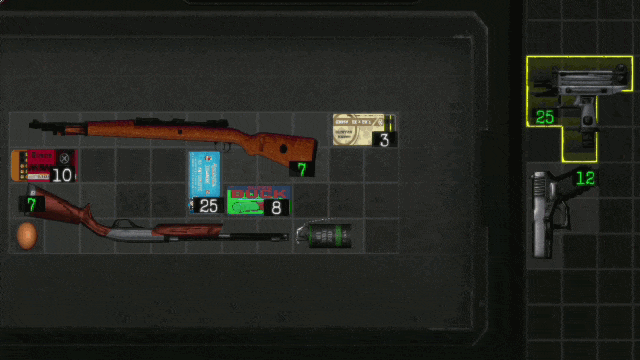Review | Save Room - I Like To Move It
Even though it isn’t the healthiest idea, I always begin by eating. Large fish come first, then mixed herbs, and finally eggs. I make sure to gradually poison myself with rotten eggs, and only then will I neatly load ammo between guns. Sure, if I’m not careful I could make things impossible for myself, tidiness and order come first. You have to evenly space each gun into the slots, biggest to smallest, working from the outside in. I’m not talking about any strange Christmas dinner traditions, I’m describing my inventory management ritual at the start of every Resident Evil 4 level.
It might sound strange to say this about one of the best games of all time, but moving items around has always been one of my favourite parts of Leon’s very bad European holiday. That’s why I’m happy Save Room exists. It’s a near-perfect recreation of the Resident Evil 4 inventory system tweaked in such a way as to turn it into a straight-up puzzle game. It’s so similar that my very scientific method organisation method, which has served me so well in Capcom’s classic, still works perfectly in this indie game.
Left… Left a bit… Little more… Perfect.
There is a slavish dedication to emulating Leon’s attache case and this eye for detail only comes from a sincere adoration of the original game. The visuals of the weapons, items and menus sell the homage upfront, but nuances of how the menus feel and act feel make it work. From the timing of the text popping up, to the pace that your cursor moves. Even the music is a soft airy wall of white noise with heavily reverberated piano and strings. It really captures the relaxing safety of Resident Evil’s safe rooms without being specific to any one game. My favourite little detail in Save Room is that you can examine every item with descriptions fitting of a survival horror game. There’s no real need for this, the illusions to mechanics of a larger game that Fractal Project made don’t exist, but It just adds to the familiarity.
This all ends up feeding into a very powerful driver of the video games industry’s lifeblood: nostalgia. Something as simple as a menu can pull me back to being a very young greasy teenager being driven around from store to store by my parents, hunting for Resident Evil 4 on its Gamecube launch day. Tracking it down to literally “the last games shop in town”. Despite a 17” CRT TV and a short controller cable, I was still blown away by what I believe is a perfect game.
Who needs to use a gun, when you can look at it?
There’s a powerful comfort in these sorts of associations. It’s not just that Save Room reminds me of a better game, instead, it manages to recreate and condense the safe feeling that the Resi franchise has tied to being able to manage items like this. The titular save rooms were the only place with comforting gentle music, and item storage. But sorting items and inventory during intense fighting of undead hordes of zombies, mutants, and zombie mutants gave respite. Managing your inventory stopped time, and gave you a little time to breathe, before getting back to the survival horror at your own pace.
At its most basic, Save Room’s puzzles are a block logic game: fit all the block shapes into a bigger shape. Repeat through 40 levels and you win. To clear more space, guns need to be reloaded and excess ammo boxes sorted. Brightly coloured herbs get mixed and presumably smoked. It’s simple but, it works just as well in this game as it did in RE4.
Even still, there are a few things that sit outside the rules of the game that inspired Save Room. Mixing gunpowder A, B, or C combos make different ammo, that you can then load into guns to clear more space. It adds a little more depth while giving a loving nod to later games in parts of the franchise it loves so dearly. Save Room even takes the time to acknowledge some of Resident Evil’s more illogical aspects that fans usually joke about. A quirky gimmick I love is that if you (let's say) eat a rotten egg, you’ll poison yourself. However, this will actually work out in your favour, as you can then heal yourself, and free up even more space.
“What you thinking about, babe?”
”Zombies… Tetris… Bingo.”
That said, this accuracy can also be to Save Room’s detriment. Doing this inventory-Tetris far more frequently than you ever would when slaying zombies means that longer levels can begin to feel slightly repetitive and slow. Also having to restart a level from the beginning when you realise you’ve mismanaged yourself into a corner never feels good, and it would be nice if you have an undo button.
Save Room offers a fantastic few hours of cosy nostalgia at a very low price point. It begins with simple puzzles just introducing new mechanics but it always feels satisfying to clear a screen. It also eventually ramps up with some properly involved and engaging puzzles by the end. Beyond that, there’s a great satisfaction to be had slotting things into place. There’s even some beauty here. Despite the confined restrictions, people can still show some individual expression in the simplicity of how they organise and tidy some items away.
For anyone with a reverence for Resident Evil 4, Save Room is definitely worth a try and makes that wait for the remake a little easier.






![Review | The Knight Witch - Wicked [Cool] Witch](https://images.squarespace-cdn.com/content/v1/5caf2dea93a63238c9069ba4/1674902221285-F8Y8XHI78OWJGDAMEVIN/The+Knight+Witch+0.png)


